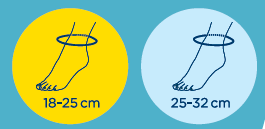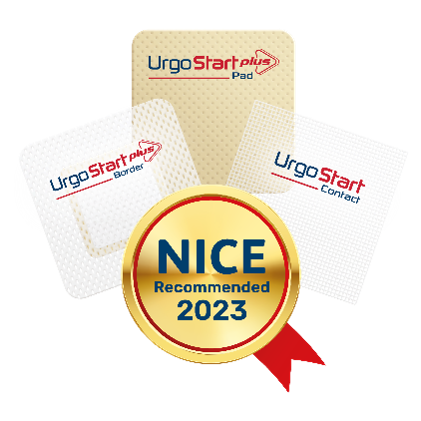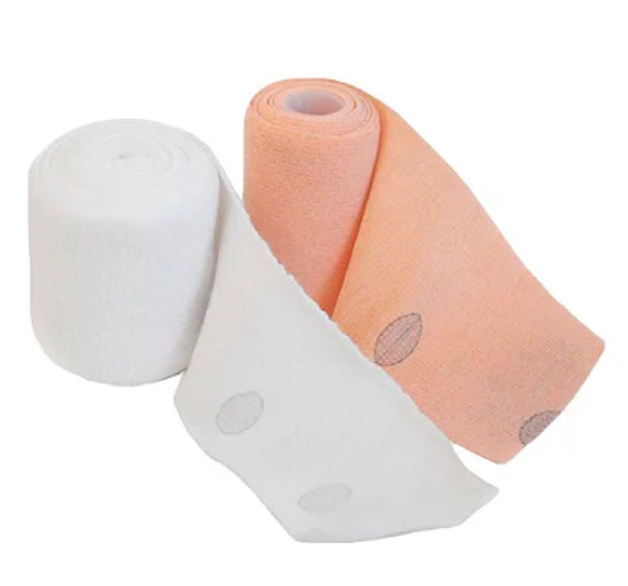UrgoKTwo
Step-by-step application guide
loading...
Leg type
Venous hypertension can be associated with the formation of fibrin around the capillaries, with fibrosis and hardened skin in the gaiter area. This leads to a distorted leg shape.
We refer to inverted champagne bottle shape where the circumference of the upper calf is much bigger than that of the ankle
Leg type
Venous hypertension can be associated with the formation of fibrin around the capillaries, with fibrosis and hardened skin in the gaiter area. This leads to a distorted leg shape.
Leg type
Some areas (tibial crest, Achilles tendon, bone protusions…) are at risk of excess pressure, especially with patients presenting very thin legs or calf muscle wastage.
Leg type
Venous hypertension can cause oedema as the fluid and waste metabolites are unable to be re-absorbed back into the venous system.
of



To choose the correct size, measure the ankle circumference, approximately 2 cm above the malleolus.

If the oedema is too big, you may need to palpate the leg to find the malleolus

More information on dressing:
UrgoStart Plus treatment range dressings are recommended by National Institute for Health and Care Excellence (NICE) in first intention for leg ulcers. (same illustration as FAQ)
Source : National Institute for Health and Care Excellence (NICE), UrgoStart for treating leg ulcers and diabetic foot ulcers,
https://www.nice.org.uk/guidance/mtg42, April 2023
of
After the dressing has been applied on the wound and before applying the compression bandage, examine the shape of the leg and identify any areas at risk of excessive pressure (bony prominences).
If necessary, apply wadding such as K-Soft on the leg to ensure you achieve an inverted cone shape – smaller on the ankle and gradually wider up to the calf muscle – and to protect any bony prominences (tibial crest zone, malleolus and the dorsiflex).
Steps
DISCLAIMER: If the patient presents severe oedema or lymphoedema with skin folds, we suggest using a single-layer inelastic compression bandage.
of
After the dressing has been applied on the wound and before applying the compression bandage, examine the shape of the leg and identify any areas at risk of excessive pressure (bony prominences).
If necessary, apply wadding such as K-Soft on the leg to protect any bony prominences (tibial crest zone, malleolus and the dorsiflex).
Tibial crest zone
You can either cut a length of K-Soft and apply vertically along the tibial crest or apply K-Soft in spiral around the leg, depending on your local guidelines and your own clinical judgment.
Malleolus and the dorsiflex
Apply two turns of K-Soft around the ankle to encompass both the malleolus and the dorsiflex
Steps
If your patient has:
A regular leg shape
Minimal oedema
None to low wound exudate level
Is willing, and able to self-care
The indicated Urgo Medical product is Altipress
Available as a Standard or Made-to-Measure Leg Ulcer Hosiery Kit (40 mmHg)
More information
https://measurego.co.uk/by-product/class

of
After the dressing has been applied on the wound and before applying the compression bandage, examine the shape of the leg and identify any areas at risk of excessive pressure (bony prominences).
If necessary, apply wadding such as K-Soft on the leg to ensure you achieve an inverted cone shape – smaller on the ankle and gradually wider up to the calf muscle – and to protect any bony prominences (tibial crest zone, malleolus and the dorsiflex).



Steps
Why shaping the leg?
Venous leg ulcer healing requires application of therapeutic compression, enabling the blood to rise from the bottom to the top of the body.
To enable blood to move up along the leg, compression should be degressive from the ankle (~40 mmHg) to the knee (~20 mmHg). For this, the patient’s leg should be shaped like an inverted cone. If this is not the case, a padding device (foam, wadding, cushions, etc.) may be used to re-form an inverted cone shape
of
After the dressing has been applied on the wound and before applying the compression bandage, examine the shape of the leg and identify any areas at risk of excessive pressure (bony prominences).
If necessary, apply wadding such as K-Soft on the leg to ensure you achieve an inverted cone shape – smaller on the ankle and gradually wider up to the calf muscle – and to protect any bony prominences (tibial crest zone, malleolus and the dorsiflex).
Steps
Why shaping the leg?
Venous leg ulcer healing requires application of therapeutic compression, enabling the blood to rise from the bottom to the top of the body.
To enable blood to move up along the leg, compression should be degressive from the ankle (~40 mmHg) to the knee (~20 mmHg). For this, the patient’s leg should be shaped like an inverted cone. If this is not the case, a padding device (foam, wadding, cushions, etc.) may be used to re-form an inverted cone shape.
of
After the dressing has been applied on the wound and before applying the compression bandage, examine the shape of the leg and identify any areas at risk of excessive pressure (bony prominences).
If necessary, apply wadding such as K-Soft on the leg to ensure you achieve an inverted cone shape – smaller on the ankle and gradually wider up to the calf muscle – and to protect any bony prominences (tibial crest zone, malleolus and the dorsiflex).
Steps
Why protecting those areas? Which ones?
It is sometimes necessary to use padding devices (foam, wadding, cushions, etc.) to protect areas at risk of excess pressure (bone protrusions) to avoid possible lesions. These excess pressure areas are frequently located on the tibial crest, Achilles tendon, dorsum of the foot or other vulnerable tendons.
of



If you have had to apply excessive wadding to shape and protect the leg, measure again the ankle circumference, approximatively 2cm above the malleolus, to make sure you selected the correct kit size.

Steps
If the oedema is too big, you may need to palpate the leg to find the malleolus.
of



If you have had to apply excessive wadding to shape and protect the leg, measure again the ankle circumference, approximatively 2cm above the malleolus, to make sure you selected the correct kit size.

Steps
If the oedema is too big, you may need to palpate the leg to find the malleolus.
of



If you have had to apply excessive wadding to shape and protect the leg, measure again the ankle circumference, approximatively 2cm above the malleolus, to make sure you selected the correct kit size.

Steps
If the oedema is too big, you may need to palpate the leg to find the malleolus.
of



If you have had to apply excessive wadding to shape and protect the leg, measure again the ankle circumference, approximatively 2cm above the malleolus, to make sure you selected the correct kit size.

Steps
If the oedema is too big, you may need to palpate the leg to find the malleolus
of



If you have had to apply excessive wadding to shape and protect the leg, measure again the ankle circumference, approximatively 2cm above the malleolus, to make sure you selected the correct kit size.

Steps
If the oedema is too big, you may need to palpate the leg to find the malleolus.
of
The UrgoKTwo kit is composed of a short-stretch bandage (white - K-Tech) and a long-stretch (beige - K-Press) bandage.
To start, pick up K-Tech, the white short-stretch bandage and open it.
The white bandage should be applied on the leg first, then the beige bandage will come on top.

of



How to hold the bandage roll?
Apply the white K-Tech bandage positioning the roll upward (pressure indicators visible).
18-25cm kit – Start with the pressure indicators facing away from the toes (facing the patient).
25-32cm kit – The pressure indicators are placed in the centre.
How to apply?
Start at the base of the toes with one or two turns. Apply a moderate stretch, based on your own clinical judgement (vascular status, foot shape and presence of oedema), without applying excessive pressure to prevent any slippage.
of



How to hold the bandage roll?
Apply the white K-Tech bandage positioning the roll upward (pressure indicators visible).
18-25cm kit – Start with the pressure indicators placed towards the patient’s toes (facing you).
25-32cm kit – The pressure indicators are placed in the centre.
How to apply?
Start at the base of the toes with one or two turns. Apply a moderate stretch, based on your own clinical judgement (vascular status, foot shape and presence of oedema), without applying excessive pressure to prevent any slippage.
of



Secure the heel by applying a figure of 8 around the ankle, ensuring the heel is completely covered.
of



Secure the heel by applying a figure of 8 around the ankle, ensuring the heel is completely covered.
of



Make sure you achieve the correct stretch using the pressure indicators: from rugby ball to football shape.
Steps
The PresSure indicators should be pointing towards the bottom
of



Make sure you achieve the correct stretch using the pressure indicators: from rugby ball to football shape.
of



For the 18-25cm kit, achieve a 50% overlap.
For the 25-32cm kit, achieve a 2/3 overlap.
Steps
The PresSure indicators should be fully covered by the overlaps of the bandage.
of



For the 18-25cm kit, achieve a 50% overlap.
For the 25-32cm kit, achieve a 2/3 overlap.
These overlaps should fully cover the pressure indicators.
of



After the ankle, bandage up to the knee in a spiral, achieving the correct stretch and overlap.
Steps
The PresSure indicators should be fully covered by the overlaps of the bandage.
of



From the ankle, bandage the leg up to the knee in spirals, using the pressure indicators as a guide for the correct stretch and overlap, as in previous steps.
of



Finish 2 cm below the back of the knee and cut off any excess bandage.
Steps
Bandaging should stop at the 'Tibial Tuberosity’, ending at the back of the knee one or two fingers lower than the popliteal fossa.
of



Finish 2 cm below the back of the knee and cut off any excess bandage.
Steps
Bandaging should stop at the 'Tibial Tuberosity’, ending at the back of the knee one or two fingers lower than the popliteal fossa.
of



For patient comfort, allow a small border of layer 1 (K-Tech the white bandage) at the toes before applying K-Press, the 2nd beige bandage.
of



For patient comfort, allow a small border of layer 1 (K-Tech the white bandage) at the toes before applying K-Press, the 2nd beige bandage.
of



Apply the K-Press bandage (beige long-stretch bandage) - on top of K-Tech bandage using the same technique.
Steps
To apply the correct tension, stretch the bandage fully and ensure that the oval becomes a circle.
To achieve the correct overlap, cover pressure indicators so that 50% of the previous wrap is covered for the 18-25cm kit, or 2/3 for the 25-32cm kit.
of



Apply the K-Press bandage (beige long-stretch bandage) - on top of K-Tech bandage using the same technique.
Steps
To apply the correct tension, stretch the bandage fully and ensure that the oval becomes a circle.
To achieve the correct overlap, cover pressure indicators so that 50% of the previous wrap is covered for the 18-25cm kit, or 2/3 for the 25-32cm kit.
For the 18-25cm kit, the pressure spot indicators should remain visible.
of



Here again for patient comfort, allow a small border of layer 1 (K-Tech the white bandage) at the top. Cut off any excess bandage.
of



Here again for patient comfort, allow a small border of layer 1 (K-Tech the white bandage) at the top. Cut off any excess bandage.
of



Apply gentle pressure with the hands along the leg to ensure correct cohesion of the 2nd bandage
of



Apply gentle pressure with the hands along the leg to ensure correct cohesion of the 2nd bandage
of
When you’re finished, check the back of the leg to make sure the bandages are correctly applied and ask your patient if the bandages feel comfortable.
Steps
What about the other leg?
A patient treated for a venous leg ulcer or mixed leg ulcer with bandages on one leg might be at risk of developing one on the other leg in the future. To prevent this, wearing appropriate compression hosiery is recommended.
Learn more about our hosiery range on https://www.urgomedical.co.uk/ and https://measurego.co.uk/.